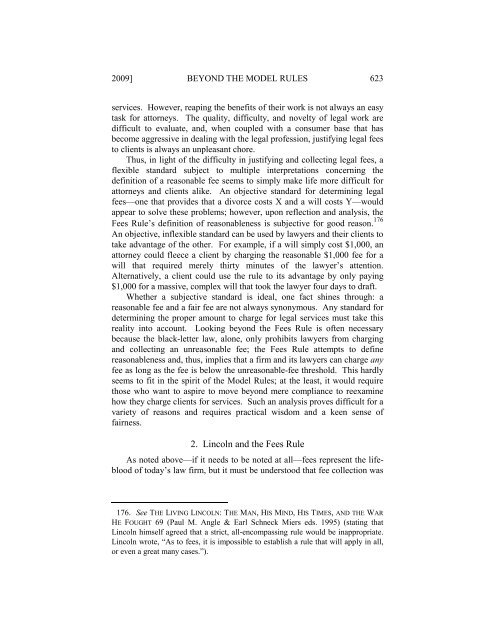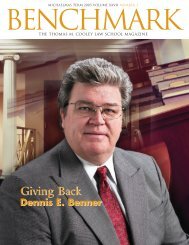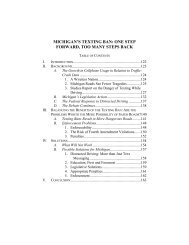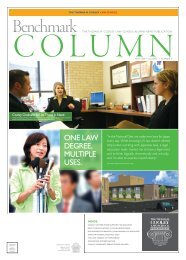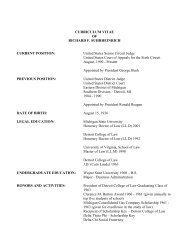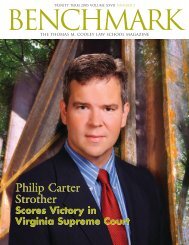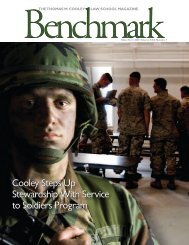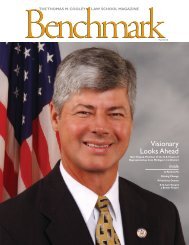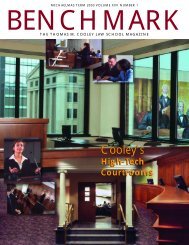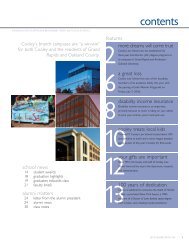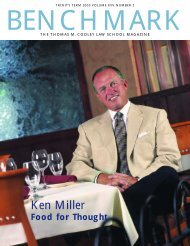Beyond The Model Rules - Thomas M. Cooley Law School
Beyond The Model Rules - Thomas M. Cooley Law School
Beyond The Model Rules - Thomas M. Cooley Law School
Create successful ePaper yourself
Turn your PDF publications into a flip-book with our unique Google optimized e-Paper software.
2009] BEYOND THE MODEL RULES 623services. However, reaping the benefits of their work is not always an easytask for attorneys. <strong>The</strong> quality, difficulty, and novelty of legal work aredifficult to evaluate, and, when coupled with a consumer base that hasbecome aggressive in dealing with the legal profession, justifying legal feesto clients is always an unpleasant chore.Thus, in light of the difficulty in justifying and collecting legal fees, aflexible standard subject to multiple interpretations concerning thedefinition of a reasonable fee seems to simply make life more difficult forattorneys and clients alike. An objective standard for determining legalfees—one that provides that a divorce costs X and a will costs Y—wouldappear to solve these problems; however, upon reflection and analysis, theFees Rule’s definition of reasonableness is subjective for good reason. 176An objective, inflexible standard can be used by lawyers and their clients totake advantage of the other. For example, if a will simply cost $1,000, anattorney could fleece a client by charging the reasonable $1,000 fee for awill that required merely thirty minutes of the lawyer’s attention.Alternatively, a client could use the rule to its advantage by only paying$1,000 for a massive, complex will that took the lawyer four days to draft.Whether a subjective standard is ideal, one fact shines through: areasonable fee and a fair fee are not always synonymous. Any standard fordetermining the proper amount to charge for legal services must take thisreality into account. Looking beyond the Fees Rule is often necessarybecause the black-letter law, alone, only prohibits lawyers from chargingand collecting an unreasonable fee; the Fees Rule attempts to definereasonableness and, thus, implies that a firm and its lawyers can charge anyfee as long as the fee is below the unreasonable-fee threshold. This hardlyseems to fit in the spirit of the <strong>Model</strong> <strong>Rules</strong>; at the least, it would requirethose who want to aspire to move beyond mere compliance to reexaminehow they charge clients for services. Such an analysis proves difficult for avariety of reasons and requires practical wisdom and a keen sense offairness.2. Lincoln and the Fees RuleAs noted above—if it needs to be noted at all—fees represent the lifebloodof today’s law firm, but it must be understood that fee collection was176. See THE LIVING LINCOLN: THE MAN, HIS MIND, HIS TIMES, AND THE WARHE FOUGHT 69 (Paul M. Angle & Earl Schneck Miers eds. 1995) (stating thatLincoln himself agreed that a strict, all-encompassing rule would be inappropriate.Lincoln wrote, “As to fees, it is impossible to establish a rule that will apply in all,or even a great many cases.”).


